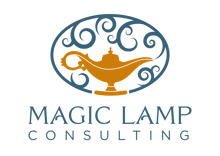Grant funding can be a game-changer for nonprofits looking to expand their impact and sustain their...
Steps to Obtaining Grant Funding After You Have Become a Nonprofit

Starting a nonprofit is an incredible way to make a difference, but securing funding to sustain your mission can be challenging. Grants are a vital source of funding for many nonprofits, providing the financial support needed to launch programs, expand services, and achieve long-term goals. With you in mind, the Magic Lamp Consulting team has compiled a list of essential steps to obtaining grant funding for your nonprofit organization.
Step 1: Understand Your Needs and Goals
Before seeking grant funding, it's crucial to have a clear understanding of your organization's needs and goals. Define what you aim to achieve with the grant money. This might include launching a new program, covering operational costs, or funding a specific project. Being clear about your objectives will help you identify the most suitable grants and articulate your needs effectively in your applications.
Step 2: Research Potential Grant Opportunities
Start by researching potential grant opportunities that align with your nonprofit’s mission and goals. Use resources like GrantWatch to find available grants. Pay attention to the eligibility criteria, deadlines, and application requirements. Creating a spreadsheet to track potential grants can be beneficial, noting key details such as application deadlines, grant amounts, and contact information.
Free Resource: Download our free Grant Listing Spreadsheet to help make grant management easier!
Step 3: Build Relationships with Funders
Establishing relationships with potential funders can significantly improve your chances of receiving a grant. Attend networking events, conferences, and workshops to connect with representatives from foundations and government agencies. Follow funders on social media, subscribe to their newsletters, and engage with their content. Building a rapport can make your application stand out when it's time to apply.
Step 4: Prepare a Strong Grant Proposal
A well-prepared grant proposal is crucial for securing funding. Here are key components to include:
- Executive Summary: Provide a concise overview of your organization, the project, or program you need funding for, and the amount of funding you are requesting.
- Organization Background: Detail your nonprofit’s history, mission, and major accomplishments. Highlight your experience and capacity to manage the project.
- Statement of Need: Explain the problem or need your project addresses. Use data and testimonials to support your case.
- Project Description: Describe your project in detail, including objectives, activities, timelines, and expected outcomes. Be clear about how the grant will be used.
- Budget: Provide a detailed budget that outlines how the grant money will be spent. Include all relevant costs and justify your expenses.
- Evaluation Plan: Explain how you will measure the success of the project. Describe the methods and metrics you will use to evaluate outcomes.
Step 5: Follow the Guidelines Carefully
Every grant application will have specific guidelines. Read these instructions thoroughly and ensure you follow them correctly. Adhering to the guidelines shows that you respect the funder's requirements and are capable of following directions—a critical trait for managing grant funds responsibly.
Step 6: Seek Feedback and Review
Before submitting your grant proposal, seek feedback from colleagues, mentors, or grant writing professionals. They can provide valuable insights and help you identify areas for improvement. Reviewing your proposal multiple times can help catch any errors or omissions. Two sets of eyes are always better than one!
Step 7: Submit Your Application Early
Submitting your application well before the deadline can give you a competitive edge. It shows funders that you are organized and proactive. Moreover, early submission provides time to address any unforeseen issues that might arise.
Step 8: Follow Up
After submitting your application, follow up with the funder to confirm receipt and ask about the review timeline. If your application is successful, maintain regular communication with the funder. Provide updates on your project’s progress and ensure you meet all reporting requirements.
Step 9: Be Persistent and Patient
Grant funding is highly competitive, and rejection is part of the process. Don't be discouraged by a few setbacks. Use feedback from unsuccessful applications to improve future proposals. Persistence and continuous improvement are key to long-term success in securing grants.
Step 10: Leverage Success
When you do receive grant funding, leverage this success to attract more support. Publicize your grant awards on your website, social media, and in press releases. Demonstrating that funders trust your organization can attract additional grants and donations.
Securing grant funding is a vital skill for nonprofit leaders. By following these steps, you can increase your chances of obtaining the financial support needed to achieve your mission and make a lasting impact.




